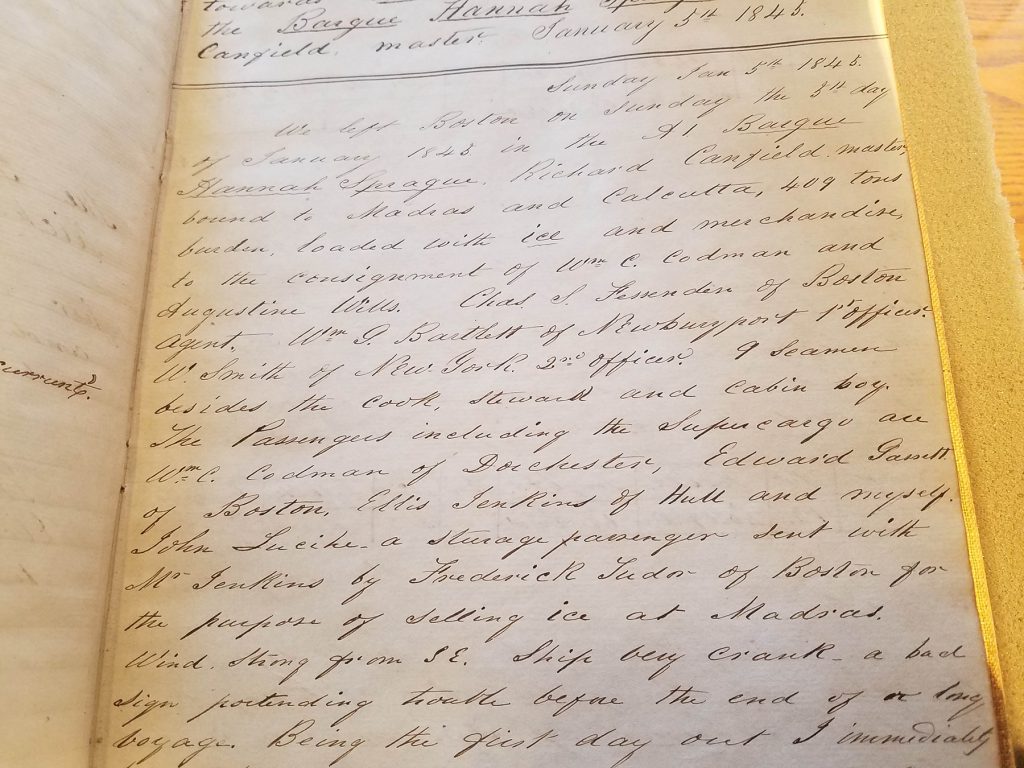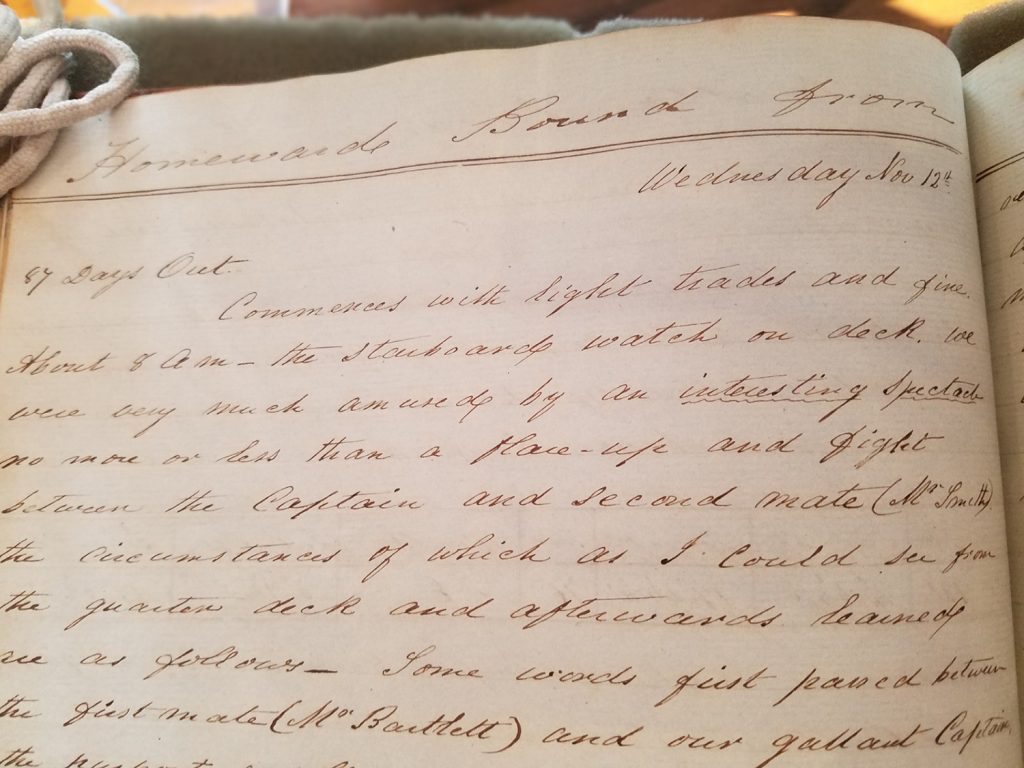By Rakashi Chand, Senior Library Assistant
“We left Boston on Sunday the 5th day of January 1845 in the Barque Hannah Sprague, Richard Canfield master, bound to Madras and Calcutta, 409 tons burden, loaded with ice and merchandise, to the consignment of Wm. C. Codman and Augustine Wills. Chas S. Fessenden of Boston Agent. Wm G. Bartlett of Newburyport 1st Officer, W. Smith of New York 2nd Officer. 9 Seamen besides the cook, steward and cabin boy. The Passengers including the Supercargo are Wm. C. Codman of Dorchester. Edward Gassett of Boston, Elis Jenkins of Hull and myself. John Lucike a (strange) passenger sent with Mr. Jenkins by Frederick Tudor of Boston for the purpose of Selling ice at Madras. Wind Strong from SE. Ship very crank- a bad sign (portending trouble) before the end of our long voyage. Being the first day out I immediately began to oversee the preparation of my State-room &c. Find it pretty difficult to walk on the deck, not being accustomed to the motion of a ship. Did not sleep very well, but was not the least bit sick.”

Thus begins Day 1 of Horatio Rotch’s 120 day journey towards Madras and Calcutta, India from Boston on a chilly January day. The log of the barque Hannah Sprague was kept by Horatio Stockton Rotch from 5 January 1845 through 25 December 1845, while on a trading voyage. Entries record longitude and latitude, course, winds, and distance traveled. One of many in the Society’s collection, I find this logbook to be simply remarkable. Indeed I am appreciative for his lovely legible handwriting (which I imagine is not easy aboard ship) but I am even more grateful for his detailed and honest descriptions throughout the journey. This must have been his first, as his narratives are rich in detail. The volume includes the logbooks of two subsequent journeys by Rotch: one aboard the barque Sylphide in 1846 and another on the brig Emily Bourne in 1849.
Rotch describes day to day happenings aboard the ship. It seems their journey was not in the least bit peaceful.
“ 2 Days Out
The gale kept continuing al day and increasing in violence towards night. Rained very hard and blew tremendously al night, so that the ship was in great danger of Capsizing. The ship bore up gallantly against the heavy sea, which at every plunge washed her decks, and almost overwhelmed her, and the next morning saw her safe.”
“3 Days Out
We got through the night safe, only to experience during the whole of today a constant succession of squalls, once in a while getting a peek at the sun. One of the sailors taken sick and put under my care by the Captain.”
“4 Days Out
Fair weather. Sun makes its first appearance to our great delight. First Observation taken. A Barque visible at the Southwest what name and where from we cannot find out, probably from some southern port. We are now in the South side of the gulf, and the change in climate is very manifest.”
And after two calmer days…
“7 Days Out
9 O’clock –The Storm still continues to rage, incessant squalls, very heavy sea. Blew a perfect hurricane all day and night. Thunder and lightning with most perfect squalls every five minutes. Scudding before the wind under a close-[suffered] foresail Great anxiety for the safety of the Ship and consequently of ourselves. Almost gave her up at one time during the night. The Captain said he had never experienced such a tremendous hurricane, although he has been eight voyages to the East Indies. The ship bore up gallantly (Just like a seagull) in spite of the roaring of the sea, which at every rise looked like a huge Mountain about to dash us to pieces. The scene in the Cabin was quite comical, some praying, some groaning, and most all frightened to Death, especially an Austrian name Lucike. Nobody can conceive the danger of our situation, save an eye-witness. Words cannot describe the scene.”
That was only 7 days out with another 111 to go before they would near their first destination. Personally, I would have never left land again, but as we already know, Horatio Rotch set out on the very next ship. For those who wonder what it was like to be out at sea on such a journey, this logbook is a magnificent resource. While there is simply not enough space in this post to include all the interesting details of the logbook, I will add that there is a fight scene 87 days out on the homeward bound journey. What would a sea voyage be without an “Interesting Spectacle” between the Captain and the 2nd Mate? Rotch describes the altercation in detail as “This Gentlemanly Affair took place on the starboard side of the forecastle in presence of the crew and every-body else aboard.”

Arriving in India three months later, Rotch gives a description of the Calcutta and an interesting recommendation:
“Calcutta
This is one of the largest cities in the east-indies and one to which it is well worth while to pay a visit, if only for once. It covers an immense space of ground and is three or four times the size of our largest American city (New York)…”
Turly, he must have succumbed to the lure and excitement of traveling the world, as is evident by the haste in which his next voyage begins. Horatio Stockton Rotch died in 1850 at the age of 28 and is buried in New Bedford, Mass. His thoughts and words live on through his wonderful logbook.
Interested in reading more? Visit the MHS library to view the log of the bark Hannah Sprague. Or, search our online catalog, Abigail, for logbooks. Everyone is welcome to do research in our Reading Room, so stop in the next time you are on Boylston Street, and take a journey back in time and across the Globe!

